stop start Lancia Delta 2013 Owner handbook (in English)
[x] Cancel search | Manufacturer: LANCIA, Model Year: 2013, Model line: Delta, Model: Lancia Delta 2013Pages: 295, PDF Size: 8.29 MB
Page 49 of 295

1
KNOWING YOUR CAR47
IMPORTANT The engine immobilizer function is guar-
anteed by the Lancia CODE, which is automatically ac-
tivated when the ignition key is extracted from the starter
device.
TURNING THE ALARM ON
With the doors and bonnet closed and the ignition key
either turned to STOP or removed, point the key with the
remote control towards the vehicle and press and release
button
Á.
Excluding some markets, the system produces an acoustic
warning (beep) and enables door locking.
The switching on of the alarm is preceded by a self-di-
agnosis stage: if a fault is detected, the system emits a new
acoustic signal together with the display of a message (see
“Panel warning lights” chapter).
In this case switch off the alarm by pressing
Ë, check that
all the doors, bonnet and tailgate are closed correctly;
then switch the alarm back on by pressing
Á.
If a door or the bonnet is not properly shut, it will be ex-
cluded from the testing by the alarm system.
If the alarm emits an acoustic signal even when the doors,
bonnet and tailgate are correctly closed, a failure has oc-
curred in system operation. Contact a Lancia Dealership.IMPORTANT Centrally locking the doors using the metal
insert on the key does not activate the alarm.
IMPORTANT The alarm is adapted to meet requirements
in various countries.
TURNING THE ALARM OFF
Press button
Ëon the key with the remote control.
The following operations are performed (excluding some
markets):
❍the direction indicators flash briefly twice;
❍two brief acoustic signals are emitted (“BEEP”);
❍the doors are unlocked.
IMPORTANT Activating the central opening using the
key’s metal insert does not turn the alarm off.
Page 51 of 295

1
KNOWING YOUR CAR49
IGNITION DEVICE
The key can be turned to 3 different positions fig. 15:
❍STOP: engine off, key can be removed, steering
locked. Some electrical devices (e.g. sound system,
central door locking system, etc.) can operate.
❍MAR: driving position. All electrical devices can op-
erate.
❍AVV: engine starting.
The ignition switch is fitted with a safety system that re-
quires the ignition key to be turned back to STOP if the
engine does not start before the starting operation can be
repeated.STEERING LOCK
Engagement
When the key is at STOP, remove the key and turn the
steering wheel until it locks.
Disengagement
Move the steering wheel slightly as you turn the ignition
key to MAR.
IMPORTANT In some parking conditions (e.g.: wheels
turned) the effort required to move the steering wheel and
disengage the steering lock may be increased.
fig. 15L0E0107m
Never remove the key while the car is mov-
ing. The steering wheel would automatically
lock as soon as you try to turn it. This also
applies to when the car is towed. Under no cir-
cumstances should aftermarket operations be car-
ried out involving steering system or steering col-
umn modifications (e.g. installation of anti-theft
device). This could negatively affect performance
and safety, invalidate the warranty, cause serious
safety problems and also result in non-compliance
of the car with type-approval requirements.
Page 73 of 295

1
KNOWING YOUR CAR71
Deactivation
Turn the ignition key to STOP.
The next time the vehicle is started (ignition key turned
to MAR), the sensor is not reactivated even if the lever is
still in position B-fig. 29. To activate the sensor, move the
lever to position A or C and then back to position B.
Rain sensor activation will be indicated by at least one
wiper “stroke” even if the windscreen is dry.CRUISE CONTROL
(constant speed regulator)
(for versions/markets, where provided)
This is an electronically controlled driving assistance de-
vice which allows the vehicle to be driven at a chosen
speed above 30 km/h on long stretches of dry, straight
roads with few variations (e.g. motorways), without hav-
ing to depress the accelerator pedal.
It is therefore not recommended to use this device on
country roads with traffic. Do not use it in town.
TURNING THE DEVICE ON
Turn the ring nut A-fig. 31 to ON.
The device must only be switched on in gears higher than
4t
h.
Do not activate the rain sensor when wash-
ing the car in an automatic car wash.
Make sure the device is switched off if there
is ice on the windscreen.
Make sure the device is switched off when-
ever the windscreen is being cleaned.
fig. 31L0E0022m
Page 78 of 295
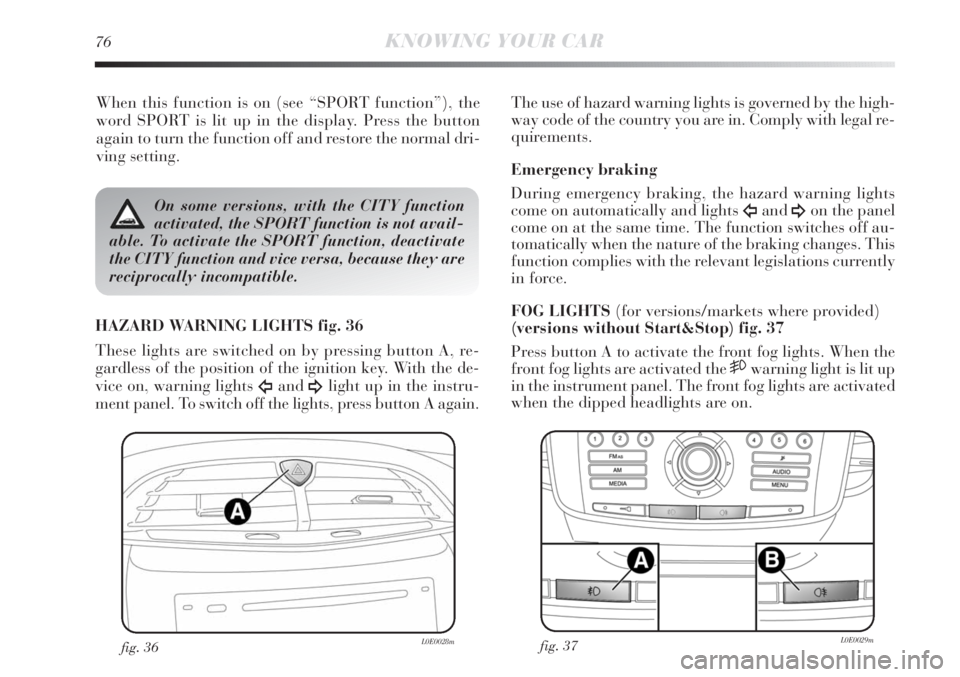
76KNOWING YOUR CAR
When this function is on (see “SPORT function”), the
word SPORT is lit up in the display. Press the button
again to turn the function off and restore the normal dri-
ving setting.
fig. 36L0E0028mfig. 37L0E0029m
The use of hazard warning lights is governed by the high-
way code of the country you are in. Comply with legal re-
quirements.
Emergency braking
During emergency braking, the hazard warning lights
come on automatically and lights
Îand¥on the panel
come on at the same time. The function switches off au-
tomatically when the nature of the braking changes. This
function complies with the relevant legislations currently
in force.
FOG LIGHTS (for versions/markets where provided)
(versions without Start&Stop) fig. 37
Press button A to activate the front fog lights. When the
front fog lights are activated the
5warning light is lit up
in the instrument panel. The front fog lights are activated
when the dipped headlights are on.
On some versions, with the CITY function
activated, the SPORT function is not avail-
able. To activate the SPORT function, deactivate
the CITY function and vice versa, because they are
reciprocally incompatible.
HAZARD WARNING LIGHTS fig. 36
These lights are switched on by pressing button A, re-
gardless of the position of the ignition key. With the de-
vice on, warning lights
Îand¥light up in the instru-
ment panel. To switch off the lights, press button A again.
Page 79 of 295
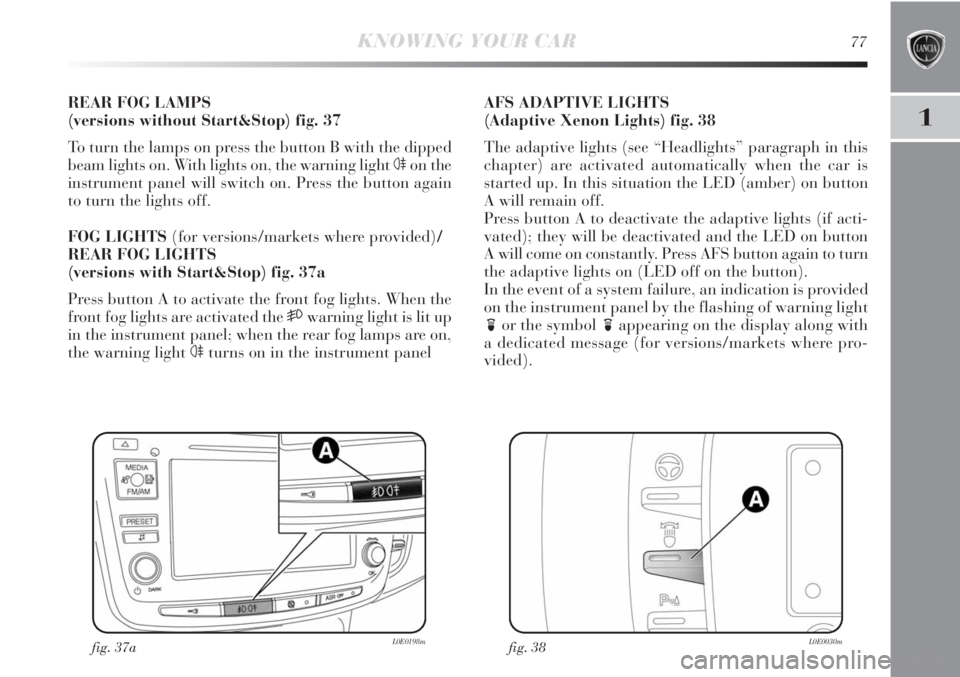
1
KNOWING YOUR CAR77
REAR FOG LAMPS
(versions without Start&Stop) fig. 37
To turn the lamps on press the button B with the dipped
beam lights on. With lights on, the warning light
4on the
instrument panel will switch on. Press the button again
to turn the lights off.
FOG LIGHTS (for versions/markets where provided)/
REAR FOG LIGHTS
(versions with Start&Stop) fig. 37a
Press button A to activate the front fog lights. When the
front fog lights are activated the 5warning light is lit up
in the instrument panel; when the rear fog lamps are on,
the warning light 4turns on in the instrument panel
fig. 38L0E0030m
AFS ADAPTIVE LIGHTS
(Adaptive Xenon Lights) fig. 38
The adaptive lights (see “Headlights” paragraph in this
chapter) are activated automatically when the car is
started up. In this situation the LED (amber) on button
A will remain off.
Press button A to deactivate the adaptive lights (if acti-
vated); they will be deactivated and the LED on button
A will come on constantly. Press AFS button again to turn
the adaptive lights on (LED off on the button).
In the event of a system failure, an indication is provided
on the instrument panel by the flashing of warning light
for the symbol
fappearing on the display along with
a dedicated message (for versions/markets where pro-
vided).
fig. 37aL0E0198m
Page 94 of 295
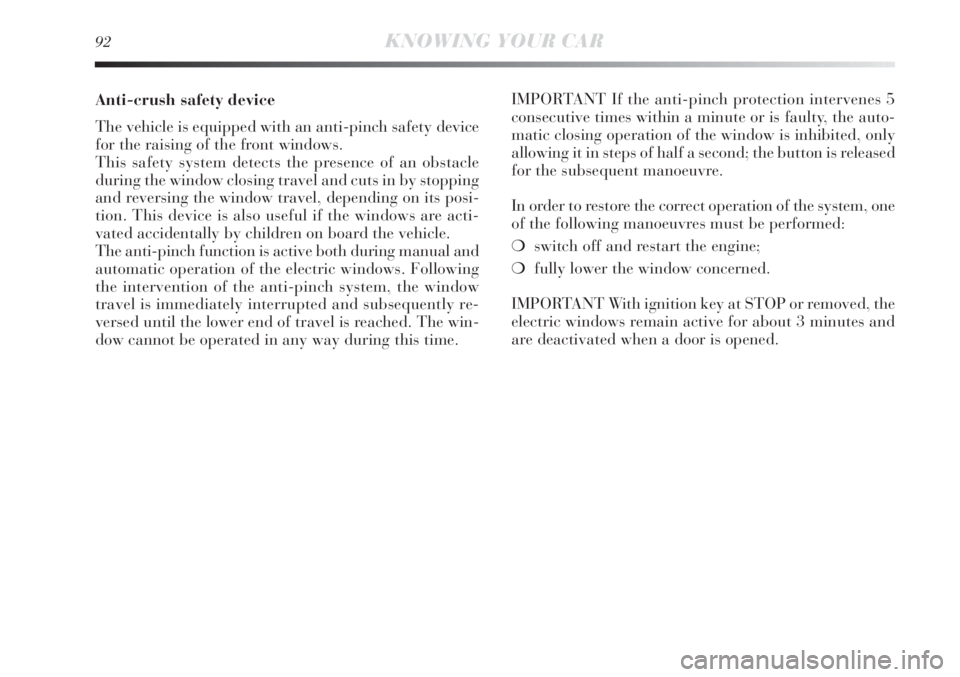
92KNOWING YOUR CAR
Anti-crush safety device
The vehicle is equipped with an anti-pinch safety device
for the raising of the front windows.
This safety system detects the presence of an obstacle
during the window closing travel and cuts in by stopping
and reversing the window travel, depending on its posi-
tion. This device is also useful if the windows are acti-
vated accidentally by children on board the vehicle.
The anti-pinch function is active both during manual and
automatic operation of the electric windows. Following
the intervention of the anti-pinch system, the window
travel is immediately interrupted and subsequently re-
versed until the lower end of travel is reached. The win-
dow cannot be operated in any way during this time.IMPORTANT If the anti-pinch protection intervenes 5
consecutive times within a minute or is faulty, the auto-
matic closing operation of the window is inhibited, only
allowing it in steps of half a second; the button is released
for the subsequent manoeuvre.
In order to restore the correct operation of the system, one
of the following manoeuvres must be performed:
❍switch off and restart the engine;
❍fully lower the window concerned.
IMPORTANT With ignition key at STOP or removed, the
electric windows remain active for about 3 minutes and
are deactivated when a door is opened.
Page 103 of 295
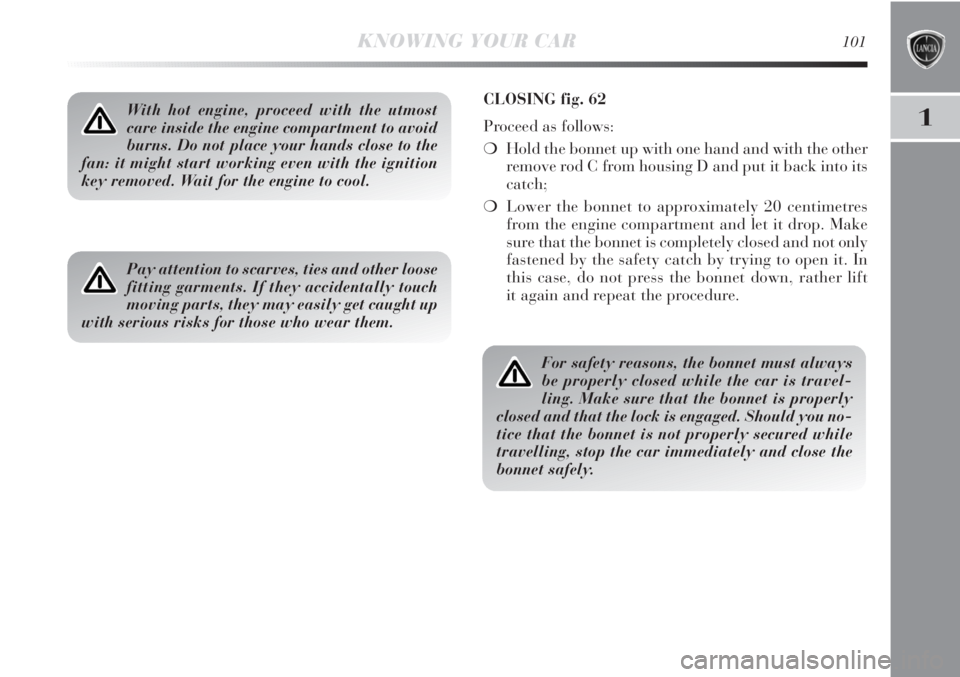
1
KNOWING YOUR CAR101
With hot engine, proceed with the utmost
care inside the engine compartment to avoid
burns. Do not place your hands close to the
fan: it might start working even with the ignition
key removed. Wait for the engine to cool.
Pay attention to scarves, ties and other loose
fitting garments. If they accidentally touch
moving parts, they may easily get caught up
with serious risks for those who wear them.
CLOSING fig. 62
Proceed as follows:
❍Hold the bonnet up with one hand and with the other
remove rod C from housing D and put it back into its
catch;
❍Lower the bonnet to approximately 20 centimetres
from the engine compartment and let it drop. Make
sure that the bonnet is completely closed and not only
fastened by the safety catch by trying to open it. In
this case, do not press the bonnet down, rather lift
it again and repeat the procedure.
For safety reasons, the bonnet must always
be properly closed while the car is travel-
ling. Make sure that the bonnet is properly
closed and that the lock is engaged. Should you no-
tice that the bonnet is not properly secured while
travelling, stop the car immediately and close the
bonnet safely.
Page 123 of 295
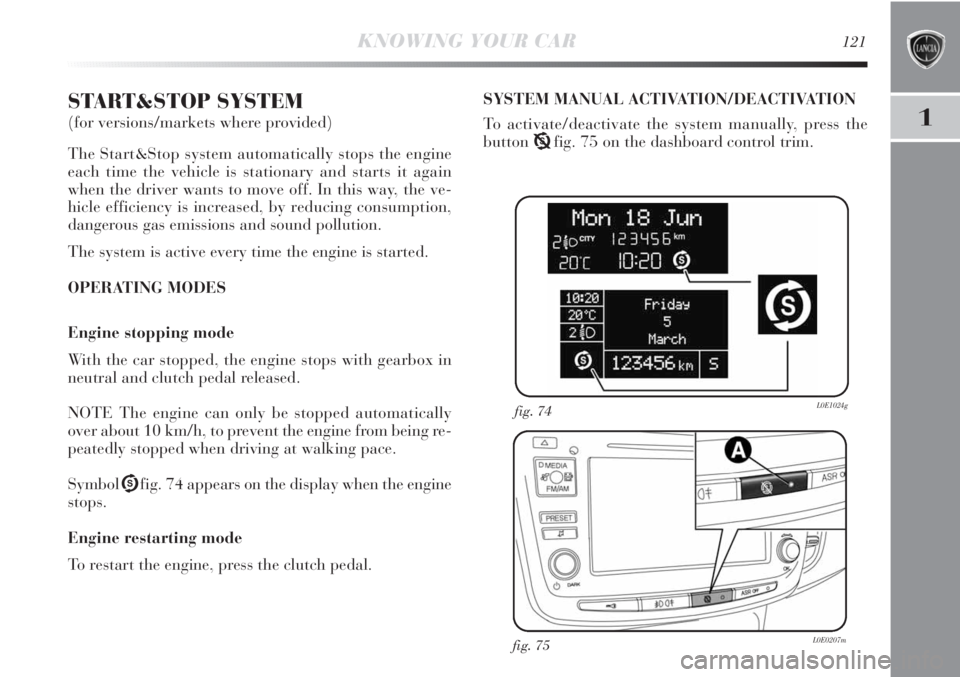
1
KNOWING YOUR CAR121
START&STOP SYSTEM
(for versions/markets where provided)
The Start&Stop system automatically stops the engine
each time the vehicle is stationary and starts it again
when the driver wants to move off. In this way, the ve-
hicle efficiency is increased, by reducing consumption,
dangerous gas emissions and sound pollution.
The system is active every time the engine is started.
OPERATING MODES
Engine stopping mode
With the car stopped, the engine stops with gearbox in
neutral and clutch pedal released.
NOTE The engine can only be stopped automatically
over about 10 km/h, to prevent the engine from being re-
peatedly stopped when driving at walking pace.
SymbolUfig. 74 appears on the display when the engine
stops.
Engine restarting mode
To restart the engine, press the clutch pedal.SYSTEM MANUAL ACTIVATION/DEACTIVATION
To activate/deactivate the system manually, press the
buttonTfig. 75 on the dashboard control trim.
fig. 74L0E1024g
fig. 75L0E0207m
Page 124 of 295
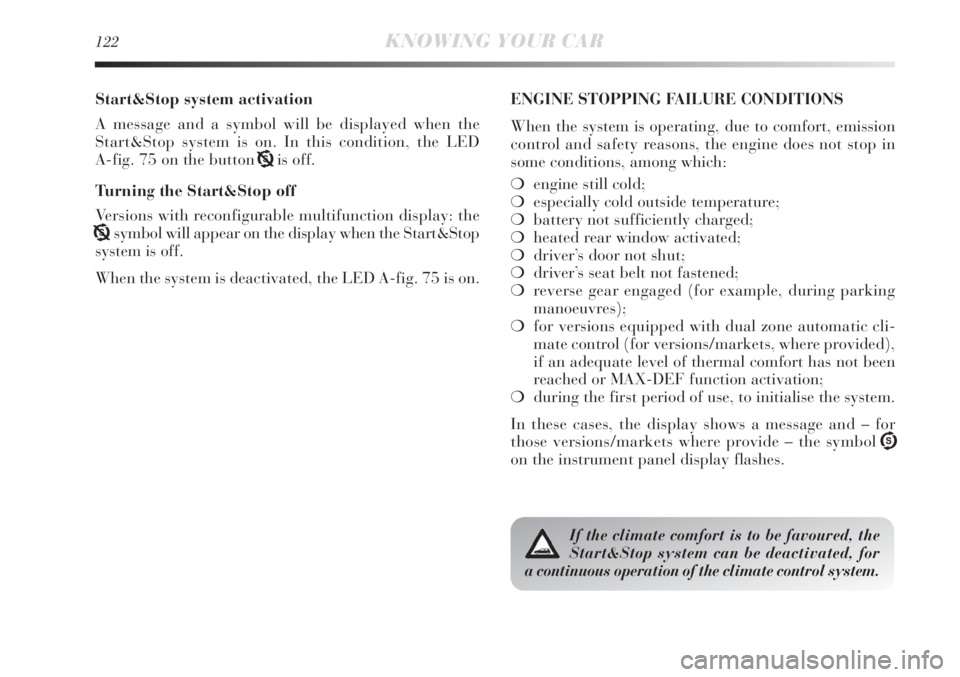
122KNOWING YOUR CAR
Start&Stop system activation
A message and a symbol will be displayed when the
Start&Stop system is on. In this condition, the LED
A-fig. 75 on the button Tis off.
Turning the Start&Stop off
Versions with reconfigurable multifunction display: the
Tsymbol will appear on the display when the Start&Stop
system is off.
When the system is deactivated, the LED A-fig. 75 is on.ENGINE STOPPING FAILURE CONDITIONS
When the system is operating, due to comfort, emission
control and safety reasons, the engine does not stop in
some conditions, among which:
❍engine still cold;
❍especially cold outside temperature;
❍battery not sufficiently charged;
❍heated rear window activated;
❍driver’s door not shut;
❍driver’s seat belt not fastened;
❍reverse gear engaged (for example, during parking
manoeuvres);
❍for versions equipped with dual zone automatic cli-
mate control (for versions/markets, where provided),
if an adequate level of thermal comfort has not been
reached or MAX-DEF function activation;
❍during the first period of use, to initialise the system.
In these cases, the display shows a message and – for
those versions/markets where provide – the symbol U
on the instrument panel display flashes.
If the climate comfort is to be favoured, the
Start&Stop system can be deactivated, for
a continuous operation of the climate control system.
Page 125 of 295

1
KNOWING YOUR CAR123
ENGINE RESTARTING CONDITIONS
For reasons of comfort, limiting harmful emissions and
safety purposes, the power unit can restart automatically
without any action on behalf of the driver if certain con-
ditions are met, including:
❍battery not sufficiently charged;
❍reduced braking system pressure, e.g. following the
brake pedal being pressed repeatedly;
❍car moving (e.g. when driving on roads with a gra-
dient);
❍engine stopping by Start&Stop system for over 3 min-
utes;
❍for versions equipped with dual zone automatic cli-
mate control (for versions/markets where provided),
to enable suitable thermal comfort or MAX-DEF
function activation.
With gear engaged, automatic engine restarting is possi-
ble only by fully pressing the clutch pedal.
The driver is informed by the displaying of a message and
– for versions/markets where provided – by the flashing
of the symbol U.Notes
If the clutch is not pressed, after 3 minutes from the en-
gine stopping, the engine can be restarted only using the
ignition key.
In cases when the engine stops and this is not desired, due
for example to the clutch pedal being released sharply
with a gear engaged, if the Start&Stop system is acti-
vated, the engine can be restarted by fully depressing the
clutch pedal or by placing the gear lever in neutral
SAFETY FUNCTIONS
When the engine is stopped by the Start&Stop system,
if the driver releases his/her seat belt and opens the dri-
ver’s or passenger’s door, the engine can be restarted only
using the ignition key.
The driver is informed by a buzzer and by the flashing
of the symbol Uon the display; on some versions, a mes-
sage is displayed as well.